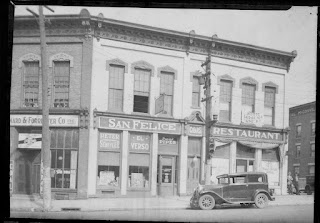Clark’s Pets, El Verso, the Knob, La Rosa. Years ago these cigars were favorites of cigar connoisseurs in Ogdensburg and elsewhere. Little remains of the flourishing cigar making industry here today, but at the turn of the century there were 39 cigar makers producing 100,000 cigars per year that were sold nationwide.
Cigar making in Ogdensburg began with Chauncey Clark, who came to the village as a carpenter in 1835. A few years later he used his knowledge of tobacco farming to build molds to make cigars. His son Stanley followed in his footsteps producing “Clark’s Pet”. Many later cigar makers learned their trade in Clark’s shop located on Ford Street (the former Surprise Block) before starting their own businesses. Eventually he sold out to the Ward Brothers, a group of 5 brothers and their father.
One of those youngsters was John Hannan, who started as a tobacco stripper at Chauncey Clark’s cigar company. He quickly learned the trade and was followed by his brothers Patrick and Richard. In 1863 the young men opened their own business over the Barber Bakery on Isabella Street. Several years later the Hannan Brothers relocated to their own building on the Hannan Block where they produced the top rated “La Rosa” cigar, as well as the “H.B.” and “Our Favorite”.
photo courtesy Albert Lauson Sr.
Another cigar maker, John Landry, opened a cigar factory on Ford St., making a cigar called “The Knob”, which became a favorite of local people. Later Charles Mulcahey continued to make the local cigar to the delight of aficionados. John O’Connor and his partners opened a factory on the corner of Ford and Paterson Streets. Their cigar “The Three Jacks” was another local favorite. Later O’Connor established his own business next to the Hotel McConville. Other favorite cigars were the “PigTail Cheroot” produced by Lawrence Powers and “The Little Tycoon” made by John McColl.
photo courtesy Ogdensburg Public Library
Many cigar makers like Joe Seguin began their careers in their teens as apprentices. Hand rolled cigars fetched a higher price (10 cents) as opposed to cigars made from molds (5 cents). Cigar makers could turn out as many as 225 hand rolled cigars per day and were paid by the piece. The average salary was $7 per week for 1,000 cigars. Workers who made 10 cent cigars were paid more because each cigar was rolled and finished by hand. In one year 15 employees at Hannan Brothers factory turned out 1 million cigars, which were sold throughout New York State. But the heyday of cigars was coming to an end.
photo courtesy City Historian's Office
During World War I machine made cigars began to flood the market and in 1919 the cigar maker union staged a strike in Ogdensburg calling for higher wages. However factory owners refused to negotiate and installed machinery, replacing the workers who hand rolled cigars. Another blow to the local cigar industry occurred as a result of Prohibition. Many local cigars were sold in saloons. When the saloons were forced to close, these cigars were sold in cigar stores with national brands. Local cigars were more expensive than national brands leading to a drastic reduction in sales. Finally, the tastes of consumers began to change. Young people began smoking cigarettes rather than cigars. By 1933 only two of the city’s cigar factories survived. The last known cigar maker in the city, Charles Mulcahy, who’s shop was located across from Hackett Hardware on North Water St., retired in 1966 after 53 years making Knob cigars. Several years later the El Verso Building, the former site of the O’Connor Algie Cigar Store was vacated and torn down. The cigar industry, which was nationally recognized, was no more.



Comments
Post a Comment